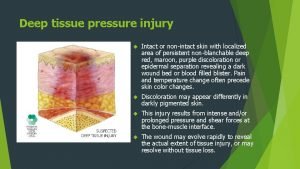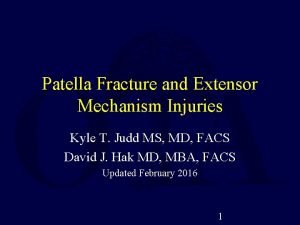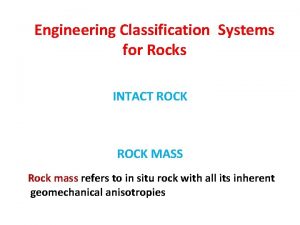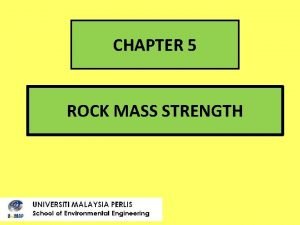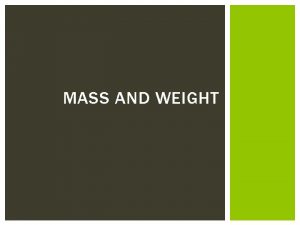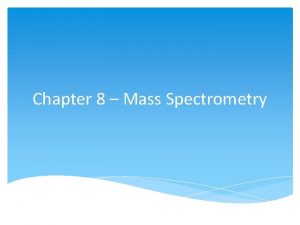Engineering Properties of ROCK INTACT ROCK ROCK MASS















- Slides: 15

Engineering Properties of ROCK (INTACT ROCK) ROCK MASS (OUTCROP)

Specific gravity Porosity Sorption Strength = Compressive, Shear, tensile Elastic properties Residual stress Rock deformation = fractures, cracks, joints, faults (active and passive) Abrasive Resistance Frost and Fire resistance Durability

Depends on many factors which include: Mineralogical composition and texture Planes of weakness Degree of mineral alteration Temperature and Pressure conditions of rock formation Pore water content Length of time and rate of changing stress that a rock experiences.

Mineralogical Composition and Texture Very few rocks are homogeneous, continuous, isotropic (non directional) and elastic. Soft Min /Hard Min Generally, the smaller the grain size, the stronger the rock.

Texture: influences the rock strength directly through the degree of interlocking of the component grains. Rock defects: such as microfractures, grain boundaries, mineral cleavages, twinning planes and planar discontinuities influence the ultimate rock strength and may act as “surfaces of weakness” where failure occurs. When cleavage has high or low angles with the principal stress direction, the mode of failure is mainly influenced by the cleavage. Anisotropy is common because of preferred orientations of minerals and directional stress history. Rocks are seldom continuous owing to pores and fissures Despite all this, it is possible to support engineering decisions with meaningful tests, calculations, and observations.

Temperature and Pressure All rock types undergo a decrease in strength with increasing temperature, and an increase in strength with increasing confining pressure. At high confining pressures, rocks are more difficult to fracture as incipient fractures are closed. Pore Solutions The presence of moisture in rocks adversely affects their engineering strength. Reduction in strength with increasing H 2 O content is due to lowering of the tensile strength, which is a function of the molecular cohesive strength of the material. Time-dependent Behaviour Most strong rocks , like granite show little time-dependent strain or creep.

Since there are vast ranges in the properties of rocks, Engineers rely on a number of basic measurements to describe rocks quantitatively. These are known as Index Properties of Rocks: Porosity- Identifies the relative proportions of solids & voids Density- a mineralogical constituents parameter; Sonic Velocity- evaluates the degree of fissuring; Permeability- the relative interconnection of pores; Durability- tendency for eventual breakdown of components or structures with degradation of rock quality, and Strength- existing competency of the rock fabric binding components.

Porosity: Proportion of void space given by- n = p/ t , where p is the pore volume and t is the total volume. Typical values for sandstones are around 15%. In Igneous and Metamorphic rocks, a large proportion of the pore space (usually < 1 -2%) occurs as planar “fissures”. With weathering this increases to > 20%. Porosity is therefore an accurate index of rock quality. Density: Rocks exhibit a greater range in density than soils. Knowledge of the rock density is important to engineering practice. A concrete aggregate with higher than average density can mean a smaller volume of concrete required for a gravity retaining wall or dam. Expressed as weight per unit volume. Sonic Velocity: Use longitudinal velocity Vl measured on rock core. Velocity depends on elastic properties and density, but in practice a network of fissures has an overriding effect. Can be used to estimate the degree of fissuring of a rock specimen by plotting against porosity (%).

Permeability: the degree of interconnection between pores / fissures, its variation with change in normal stress assesses the degree of fissuring of a rock. Dense rocks like granite, basalt, schist and crystalline limestone possess very low permeabilities as lab specimens, but field tests can show significant permeability due to open joints and fractures. Durability: Exfoliation, hydration, slaking, solution, oxidation & abrasion all lower rock quality. Measured by Franklin and Chandra’s (1972) “slake durability test”. Approximately 500 g of broken rock lumps (~ 50 g each) are placed inside a rotating drum which is rotated at 20 revolutions per minute in a water bath for 10 minutes. The drum is internally divided by a sieve mesh (2 mm openings) and after the 10 minutes rotation, the percentage of rock (dry weight basis) retained in the drum yields the “slake durability index (Id)”. A six step ranking of the index is applied (very highvery low).

Strength- Use Point Load Test of Broch and Franklin (1972). Irregular rock or core samples are placed between hardened steel cones and loaded until failure by development of tensile cracks parallel to the axis of loading. IS = P/D 2 , where P= load at rupture; D= distance between the point loads and I s is the point load strength. The test is standardised on rock cores of 50 mm due to the strength/size effect Relationship between point load index (I s) and unconfined compression strength is given by: q u =24 X I s (50) where q u is the unconfined compressive strength, and I s (50) is the point load strength for 50 mm core. All of the above are measured on Lab specimens, not rock masses/ outcrops, which will differ due to discontinuities at different scales.

Various Strength Tests • • • Confined/Triaxial Test Unconfined/uniaxial Test Ring shear Test Brazalian Test Point Load Test Schmidt Hammer Test = based on rebound from rock surface

Brazalian Test • Consists of loading a test cylinder diametrically in such a way that the applied loads would develop tensile rupturing along the diametrical plane of the specimen. Loads are increased gradually till the specimen is fractured.

Residual Stress Additional stress created in rock by excessive loading or some disturbance, either man made or natural, may remain in the rock for rather a long time after a disturbance is over or loading is removed = this is residual stress Nature and possible change with time of residual stress are not clearly understood But their presence can be detected == by microgravity survey

Abrasive Resistance • Resistance offered by rock to mechanical wear and tear, refers to hardness of rocks • Determined by Dorry’s Abrasion Test Important in case of : roads, floors, lining in tunnel, facing stone along shore

Frost and Fire Resistance • Resistance of a rock to frost action depends on porosity • Fire resistance – important when rock used for kilns and furnaces • Monomineralic rocks (qtize, marble, lst, dolo) = greater fire resistance == uniform expansion or contraction
 Non-intact
Non-intact Intact extensor mechanism
Intact extensor mechanism Polynepritis
Polynepritis Reality testing ability
Reality testing ability Intact dentition
Intact dentition Igneous sedimentary and metamorphic rocks
Igneous sedimentary and metamorphic rocks Mass to mass equation
Mass to mass equation Mass and atomic number
Mass and atomic number Is atomic mass and relative atomic mass the same
Is atomic mass and relative atomic mass the same How to calculate percent composition by mass
How to calculate percent composition by mass Inertial mass vs gravitational mass
Inertial mass vs gravitational mass Molar solution
Molar solution Formula mass vs molar mass
Formula mass vs molar mass Molar mass units
Molar mass units Converting grams to moles
Converting grams to moles Molar mass unit
Molar mass unit
